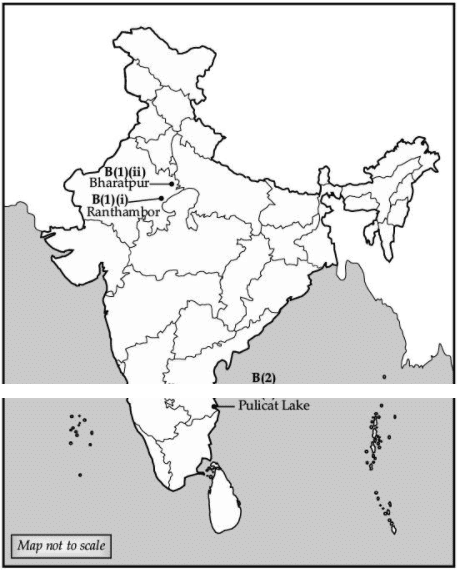Class 9 SST: Sample Question Paper- 4 (With Solutions) PDF Download
Social Science
Time : 3 Hours
M.M.: 80
General Instructions:
1. Question paper comprises five Sections - A, B, C, D and E. There are 32 questions in the question paper. All questions are compulsory.
2. Section A : Question no. 1 to 16 are Objective Type Questions of 1 mark each.
3. Section B : Question no. 17 to 22 are Short Answer Type Questions, carrying 3 marks each. Answer to each question should not exceed 80 words.
4. Section C : Question no. 23 to 26 are Source Based Questions, carrying 4 marks each.
5. Section D : Question no. 27 to 31 are Long Answer Type Questions, carrying 5 marks each. Answer to each question should not exceed 120 words.
6. Section E : Question no. 32 is Map Based, carrying 5 marks with two parts, 32.1 from History (2 marks) and 32.2 from Geography (3 marks).
7. There is no overall choice in the question paper. However, an internal choice has been provided in few questions. Only one of the choices in such questions have to be attempted.
8. In addition to this, separate instructions are given with each section and question, wherever necessary.
Section - A
Q.1. When was the Swarnajayanti Gram Swarozgar Yojana started? (1 Mark)
Ans. 1999
OR
What do you mean by hectare?
Ans. Hectare is the standard unit of measuring land.
Q.2. Study the given image carefully: (1 Mark)
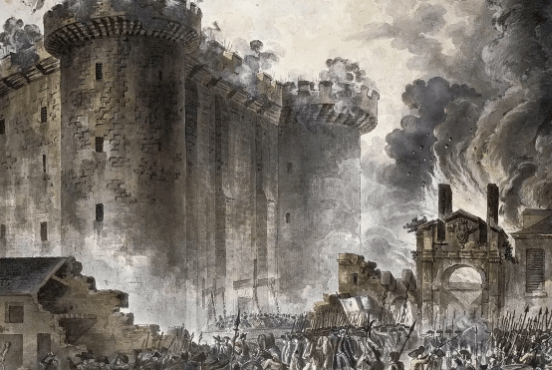 Which of the following option best signifies this cartoon?
Which of the following option best signifies this cartoon?
(a) Demolition of Bastille
(b) Democracy of People
(c) People revolt against the king
(d) None of the above
Ans. a
Q.3. When does the population become human capital? (1 Mark)
Ans: Population becomes human capital when there is an investment made in education, training and medical care.
OR
Which State has the highest literacy rate in India?
Ans. Kerala.
Q.4. Fill in the blank : (1 Mark)
Under___________________, France helped the thirteen American colonies to gain their independence from the common enemy, Britain.
Ans: Louis XVI
OR
World War I was fought between_______________ and _______________.
Ans. 1914-1918
Q.5. Assertion and Reason Type Question: In the question given below, there are two statements marked as Assertion (A) and Reason (R). Read the statements and choose the correct option. (1 Mark)
Assertion (A): Caste system is prevalent in Indian society.
Reason (R): Social exclusion reduces poverty.
Options~
(a) Both (A) and (R) are true and (R) is the correct explanation of (A).
(b) Both (A) and (R) are true and (R) is not the correct explanation of (A).
(c) (A) is correct, but (R) is wrong.
(d) (A) is wrong, but (R) is correct.
Ans. c
Q.6. What is an ecosystem? (1 Mark)
Ans. An ecosystem is a geographic area where plants, animals, and other organisms, as well as weather and landscape, work together to form a bubble of life.
Q.7. What is the other name/term for Coriolis Force?
Ans. Ferrel’s Law
Q.8. Choose the correct option from column A and B. (1 Mark)
Ans. c
Q.9. Fill in the blank : (1 Mark)
Democracy improves the quality of_____________.
Ans. Decision making
OR
According to our election law, no party or candidate can __________.
Ans. Bribe or threaten voters and appeal to them in the name of caste/religion.
Q.10. Which organ of the government has the power to interpret the Constitution? (1 Mark)
(a) Supreme Court
(b) District Court
(c) High Court
(d) Both (a) and (c)
Ans. a
Q.11. Fill in the blank : (1 Mark)
A government formed by an alliance of two or more political parties is called a ____________.
(a) Mixed Government
(b) Majority Government
(c) Ruling Government
(d) Coalition Government
Ans. d
Q.12. Fill in the blank : (1 Mark)
Free and fair elections are ensured by the _______.
(a) Election Commission
(b) Supreme Court
(c) The President of India
(d) High Court
Ans. a
Q.13. What is the time difference between IST and GMT? (1 Mark)
(a) 7½ hours behind GMT
(b) 5½ hours ahead of GMT
(c) There is no difference
(d) 5½ hours behind GMT
Ans. 5½ hours ahead of GMT
Q.14. Study the data carefully and answer the following questions : (1 Mark)
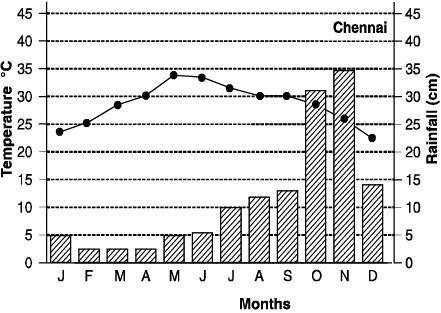 In Chennai, which months receive the highest temperature and highest rainfall?
In Chennai, which months receive the highest temperature and highest rainfall?
(a) June, November
(b) May, December
(c) May, November
(d) June, December
Ans. a
Q.15. What type of unemployment exists in rural and urban areas?
Ans. In rural regions, there is seasonal and disguised unemployment. Urban areas have mostly educated unemployment.
Q.16. By which name the well-to-do Peasants in Russia called? (1 Mark)
(a) Kulaks
(b) Kolkhoj
(c) Serfs
(d) None of these
Ans. a
Section - B
Q.17. What is Duma? How did the Duma work under Tsar? (3 Mark)
Ans. An elective legislative assembly established in 1905 by Nicholas II in Russia is known as the Duma.
(i) The Duma is the Parliament for the people of Russia.
(ii) The Tsar dismissed the first Duma within 75 days, and he re-elected the second Duma within three months.
(iii) He did not want any questioning of his authority or reducing his power.
(iv) He changed the voting laws and packed the third Duma with conservative politicians. Liberals and revolutionaries were kept out.
Q.18. Explain any three effects of the Treaty of Versailles over Germany. (3 Mark)
Ans. Impact of the Treaty of Versailles over Germany:
(i) Germany lost its overseas colonies.
(ii) It was demilitarised.
(iii) The allied armies occupied the resource-rich Rhineland.
(iv) It lost 75 per cent of its iron and 26 per cent of its coal to France, Poland, Denmark & Lithuania.
Detailed Answer:
The Treaty of Versailles was the root cause of the rise of Nazism in Germany and the Second World War.
(i) After the signing the Treaty, Germany lost its possession of the overseas colonies.
(ii) Also, it lost one-tenth of its population, 13 per cent of its territories, 75 per cent of iron, 26 per cent of coal resources to France, Poland, Denmark and Lithuania.
(iii) The Allied Powers demilitarised Germany to weaken its power.
(iv) Germany was asked to pay a compensation amount of 6 billion pounds as it was accused of causing the war.
(v) Rhineland, a resource-rich region, was occupied by the Allied Powers for much of the 1920s.
Q.19. Explain the terms : (3 Mark)
(a) Loo
(b) Kaal Baisakhi
(c) Mango showers
Ans. (a) Loo: Strong, dusty, hot and dry winds blowing during the day over the North and North- western India.
(b) Kal Baisakhi: Localised thunderstorms associated with violent winds and torrential downpours. In West Bengal, these storms are known as Kaal Baisakhi.
(c) Mango showers: Pre-monsoon showers which help in the early ripening of mangoes, are called ‘mango showers’.
Q.20. Define democracy and elaborate on any two common features of it. (3 Mark)
Ans. Democracy is a form of government that allows people to choose their rulers.
Features:
(i) Leaders elected by people rule the country.
(ii) People have the freedom to express their views.
(iii) Certain political freedom is enjoyed by the people.
OR
What are Constituencies? How many constituencies are there in India for Lok Sabha? What is the basis of the division of these Constituencies?
Ans.
(i) The country is divided into different areas for the purpose of elections. These areas are called electoral constituencies.
(ii) For the Lok Sabha elections, the country is divided into 543 constituencies at present.(iii) The basis of the division of the constituencies is on the basis of population.
Q.21. Differentiate between a ‘minimum subsistence level of living and a ‘reasonable level of living‘. (3 Mark)
Ans. (i) A “minimum” subsistence level of living contains food, cloth and shelter (the basic needs).
(ii) A ‘reasonable‘ level of living means food, cloth and shelter and health care, education, job security, and self-confidence.
Q.22. What is the difference between economic and non-economic activities? (3 Mark).
Ans. Economic activities:
(i) It involves raw material, methods of production, buying and selling, saving, spending, etc.
(ii) It covers a lot of activities including shopping, travelling, the opening of a bank account, growing vegetables and fruits, etc.
(iii) For example, a doctor working at his clinic.
Non- economic activities:
(i) It includes those activities which are undertaken for personal satisfaction. This means that these activities are not related to wealth. It won’t make you richer or poorer.
(ii) It includes hobbies that are done for one’s personal interest.
(iii) For example, a child helping an older man to cross the road.
Section - C
Q.23. Read the source given below and answer the questions that follow: (4 Mark)
There are six major controls of the climate of any place. They are: latitude, altitude, pressure and wind system, distance from the sea (continentality), ocean currents and relief features. Due to the curvature of the earth, the amount of solar energy received varies according to latitude. As a result, air temperature generally decreases from the equator towards the poles. As one goes from the surface of the earth to higher altitudes, the atmosphere becomes less dense and temperature decreases. The hills are therefore cooler during summers. The pressure and wind system of any area depend on the latitude and altitude of the place. Thus, it influences the temperature and rainfall pattern. The sea exerts a moderating influence on climate: As the distance from the sea increases, its moderating influence decreases and the people experience extreme weather conditions. This condition is known as continentality (i.e. very hot during summers and very cold during winters). Ocean currents along with onshore winds affect the climate of the coastal areas, For example, any coastal area with warm or cold currents flowing past it, will be warmed or cooled if the winds are onshore.
Finally, relief too plays a major role in determining the climate of place. High mountains act as barriers for cold or hot winds, they may also cause precipitation if they are high enough and lie in the path of rain bearing winds. The Leeward side of mountains remains relatively dry.
Answer the following MCQs by choosing the most appropriate option.
23.1. Due to the ________ of the earth, the amount of Solar energy received varies according to latitude.
(a) Circumference
(b) Radius
(c) Curvature
(d) Diameter
Ans. c
23.2. As one goes from the surface of the earth to higher altitudes, the _________ becomes less dense and temperature decreases.
(a) atmosphere
(b) biosphere
(c) hydrosphere
(d) lithosphere
Ans. a
23.3. What is the condition known as when it is very hot during summers and very cold during winters?
(a) Continuity of Climate
(b) Climatic Condition
(c) Continentality Climate
(d) Changing Climate
Ans. c
23.4. Relief feature plays a major role in determining :
(a) The temperature of a place
(b) The weather of a place
(c) The Season of a place
(d) The climate of a place
Ans. d
Q.24. Read the source given below and answer the following questions : (4 Mark)
Once the election results were announced, the sitting Chief Minister resigned. The newly elected Members of Legislative Assembly (MLAs) of Lok Dal chose Devi Lal as their leader. The Governor invited Devi Lal to be the new Chief Minister. Three days after the election results were declared, he became the Chief Minister. As soon as he became the Chief Minister, his Government issued a Government Order waiving the outstanding loans of small farmers, agricultural labourers and small businessmen. His party ruled the State for four years. The next elections were held in 1991. But this time his party did not win popular support. The Congress won the election and formed the government.
Answer the following MCQs by choosing the most appropriate option.
24.1. Where was this State Assembly election held?
(a) In Punjab
(b) In Haryana
(c) In Bihar
(d) In Rajasthan
Ans. b
24.2. In election Campaign, Devi Lal Said that if his party won the election his government would:
(a) Give new loans to farmers and small businessmen.
(b) Waive the interest of the loans bought by farmers and small businessmen.
(c) Waive the loans of farmers and small businessmen.
(d) Waive 50% of the loans bought by farmers and small businessmen.
Ans. c
24.3. What is the name of Devi Lal Party?
(a) Lok Dal
(b) Janata Lok Dal
(c) Congress
(d) Bharatiya Janata Party
Ans. a
24.4. Devi Lal's Party and its partners won ____________ seats in the State Assembly.
(a) 56 out of 80
(b) 96 out of 100
(c) 76 out of 80
(d) 66 out of 90
Ans. c
Q.25. Read the source given below and answer the following questions : (4 Mark)
Investment in human capital (through education, training, medical care) yields a return just like investment in physical capital. This can be seen directly in the form of higher incomes earned because of higher productivity of the more educated or the better trained persons, as well as the higher productivity of healthier people. India's Green Revolution is a dramatic example of how the input of greater knowledge in the form of improved production technologies can rapidly increase the productivity of scarce land resources. India's IT revolution is a striking instance of how the importance of human capital has come to acquire a higher position than that of material, plant and machinery.
Answer the following MCQs by choosing the most appropriate option.
25.1. Population is a ________ resource.
(a) Human
(b) Physical
(c) Capital
(d) Financial
Ans. a
25.2. Education, training and medical care yields a return just like investment in ________.
(a) Human Capital
(b) Physical Capital
(c) Financial Capital
(d) Fruitful Capital
Ans. b
25.3. Providing food, education and ______ facilities are considered as problems of population.
(a) housing
(b) employment
(c) health
(d) banking
Ans. c
25.4. Productivity of scarce land with improved production and technology can be seen by the example of :
(a) White Revolution
(b) Green Revolution
(c) IT Revolution
(d) Industrial Revolution
Ans. b
Q.26. Read the source given below and answer the following questions : (4 Mark)
Thirty-three year old Ram Saran works as a daily-wage labourer in a wheat flour mill near Ranchi in Jharkhand. He manages to earn around Rs 1,500 a month when he finds employment, which is not often. The money is not enough to sustain his family of six-that includes his wife and four children aged between 12 years to six mouths. He has to send money home to his old parents who live in a village near Ramgarh. His father a landless labourer, depends on Ram Saran and his brother who lives in Hazaribagh, for sustenance Ram Saran lives in a one-room rented house in a crowded basti in the outskirts of the city. It's a temporary shack built of bricks and clay tiles. His wife Santa Devi, works as a part time maid in a few houses and manages to earn another Rs 800. They manage a meagre meal of dal and rice twice a day, but there's never enough for all of them. His elder son works as a helper in a tea shop to supplement the family income and earns another Rs 300, while his 10-year-old daughter takes care of the younger siblings. None of the children go to school. They have only two pairs of handme-down clothes each. New ones are bought only when the old clothes become unwearable. Shoes are a luxury. The younger kids are undernourished. They have no access to healthcare when they fall ill.
Answer the following MCQs by choosing the most appropriate option.
26.1. What type of labourer is Ram Saran?
(a) Weekly wage labourer
(b) Monthly wage labourer
(c) Daily wage labourer
(d) Yearly wage labourer
Ans. c
26.2. How many family members of Ram Sarwan are working to make their needs meet?
(a) One
(b) Two
(c) Three
(d) Four
Ans. c
26.3. What is the total income of the family in a month?
(a) Rs. 2500
(b) Rs. 2600
(c) Rs. 2800
(d) Rs. 3000
Ans. c
26.4. Ram Saran's poverty is based as :
(a) Rural case
(b) Urban case
(c) Metropolitan city case
(b) Town case
Ans. b
Section - D
Q.27. What event in history is known as the Holocaust? How did the world come to know about the Holocaust? Explain. (5 Mark)
Ans. The persecution and mass murder of Jews by German Nazis between 1933 and 1945 is known as the Holocaust.
Sources:
(i) Information and full horror of the Holocaust was revealed after Hitler’s death.
(ii) From diaries, notebooks left behind by many Ghetto inhabitants.
(iii) Many of the Jews survived to tell the stories.
(iv) Memoirs, fictions, documentaries and poetry in many parts of the world also revealed information about the Holocaust.
OR
By the end of the twentieth century, the international reputation of the USSR as a Socialist country had declined. Explain the statement.
Ans. The above statement is true because:
(i) The style of government in the USSR was not keeping in with the ideals of the Russian Revolution.
(ii) All was not well in the Soviet Union; the dictatorial rule of the communist party began.(iii) There was no democracy, only one-party rule of the communist party prey tied.
(iv) Repressive policies like collectivisation became unpopular.
(v) The State controlled the life of the individual; this made the people unhappy.
Q.28. Describe any five characteristic features of Tropical Rain Forests of India. (5 Mark)
Ans. (i) Tropical Rain Forests are restricted to heavy rainfall areas of India.
(ii) They are at their best in areas having more than 200 cm of rainfall with a short dry season.
(iii) The trees found in these forests reach great heights up to 60 metres or even above.(iv) Since the region is warm and wet throughout the year, it has luxuriant vegetation of all kinds: trees, shrubs and creepers, giving it a multilayered structure.
(v) There is no definite time for trees to shed their leaves.
(vi) As such, these forests appear green all year-round.
(vii) Some of the commercially important trees of this forest are ebony, mahogany, rosewood, rubber and cinchona.
(viii) The common animals found in these forests are elephant, monkey, lemur and deer.
Q.29. “India has diverse climatic conditions.” Explain by giving two examples each of temperature and precipitation.
Ans. Temperature:
(i) In May, 45°C temperature is common to be experienced in Northwestern parts of India.(ii) In December and January, the temperature decreases from South to North, e.g., Chennai 25°C and in northern plains 10°C.
Precipitation:
(i) In June and July, windward side of Western Ghats receives very heavy rainfall.
(ii) Mawsynram receives the highest average rainfall in the world.
(iii) Rajasthan and parts of Gujarat get scanty rainfall.
Q.30. What is the meaning of Preamble? Explain the term Socialist and Democratic as the keywords of Preamble. (5 Mark)
Ans. The Constitution begins with a short statement of its basic values. This is called the Preamble to the Constitution.
Socialist: Wealth is generated socially and should by shared equally by all. The governments should regulate the ownership of land and industry to reduce socioeconomic inequalities.
Democratic: A form of government where people enjoy equal political rights, elect their rulers and hold them accountable. The government is run according to some basic rules.
Q.31. Why can Pakistan under General Musharraf not be called a democracy? State any five reasons. (5 Mark)
Ans. Pakistan under General Musharraf cannot be called a democracy:
(i) People in Pakistan have elected representatives to the National and Provincial Assemblies, but those elected representatives are not the real leaders.
(ii) The power to take final decisions vests with army officials and General Musharraf.
(iii) They formally have an elected Parliament and government. The civilian cabinet’s work is supervised by the National Security Council, which military officials dominate.
(iv) Pakistan’s real powers are in military officers’ hands and not with locally elected representatives.
(v) This cannot be called ‘people’s rule’. General Musharraf was responsible for the coup.
Section - E
Q.32. (A) 1. On the given political map of France, mark the following: Bordeaux
2. Identify the region where the French Revolution took place. (2 Mark)
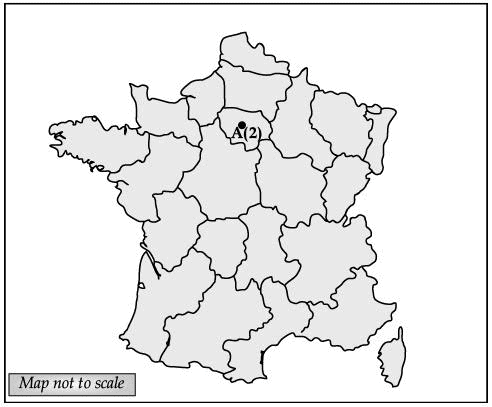
(B) 1. On the given political map of India, locate and label the following :
(i) Ranthambore
(ii) Bharatpur
2. Identify the lake on the map. (3 Mark)
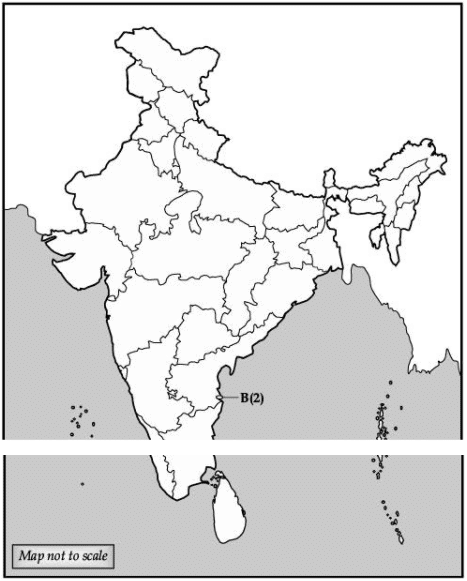 Ans. (A) 1. Ref. to map work
Ans. (A) 1. Ref. to map work
2. Paris
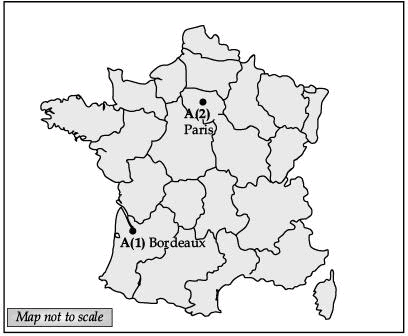 (B) 1. Ref. to map work
(B) 1. Ref. to map work
2. Pulicat Lake
